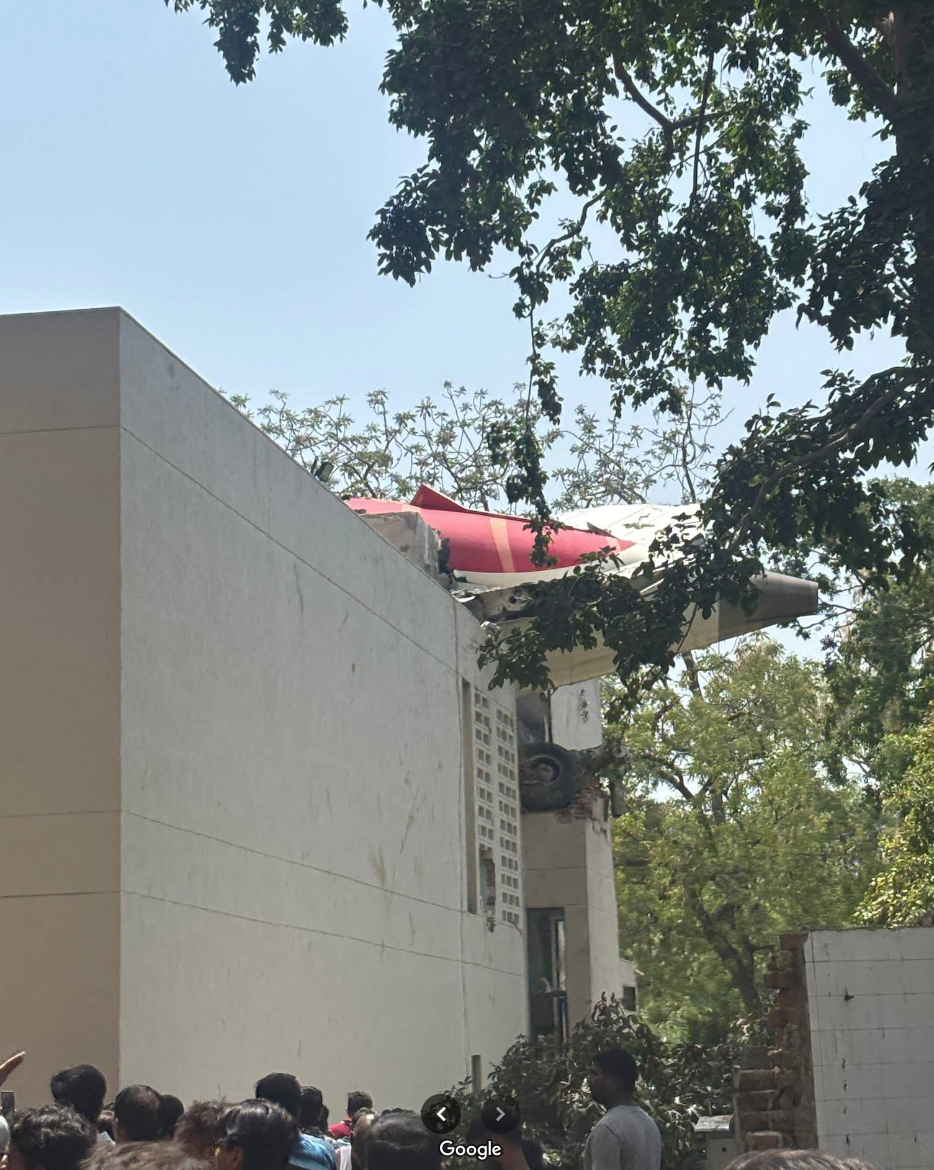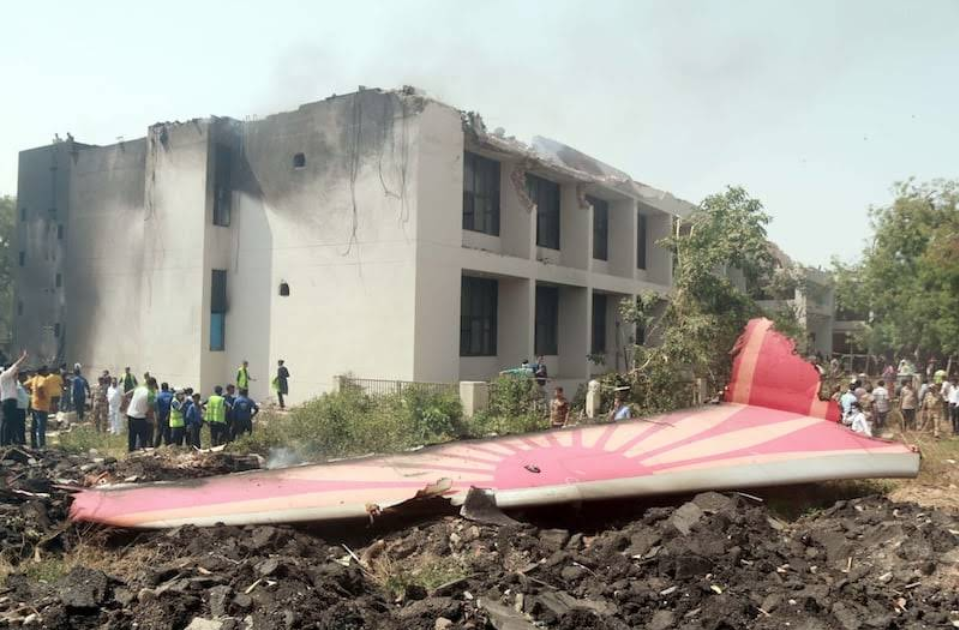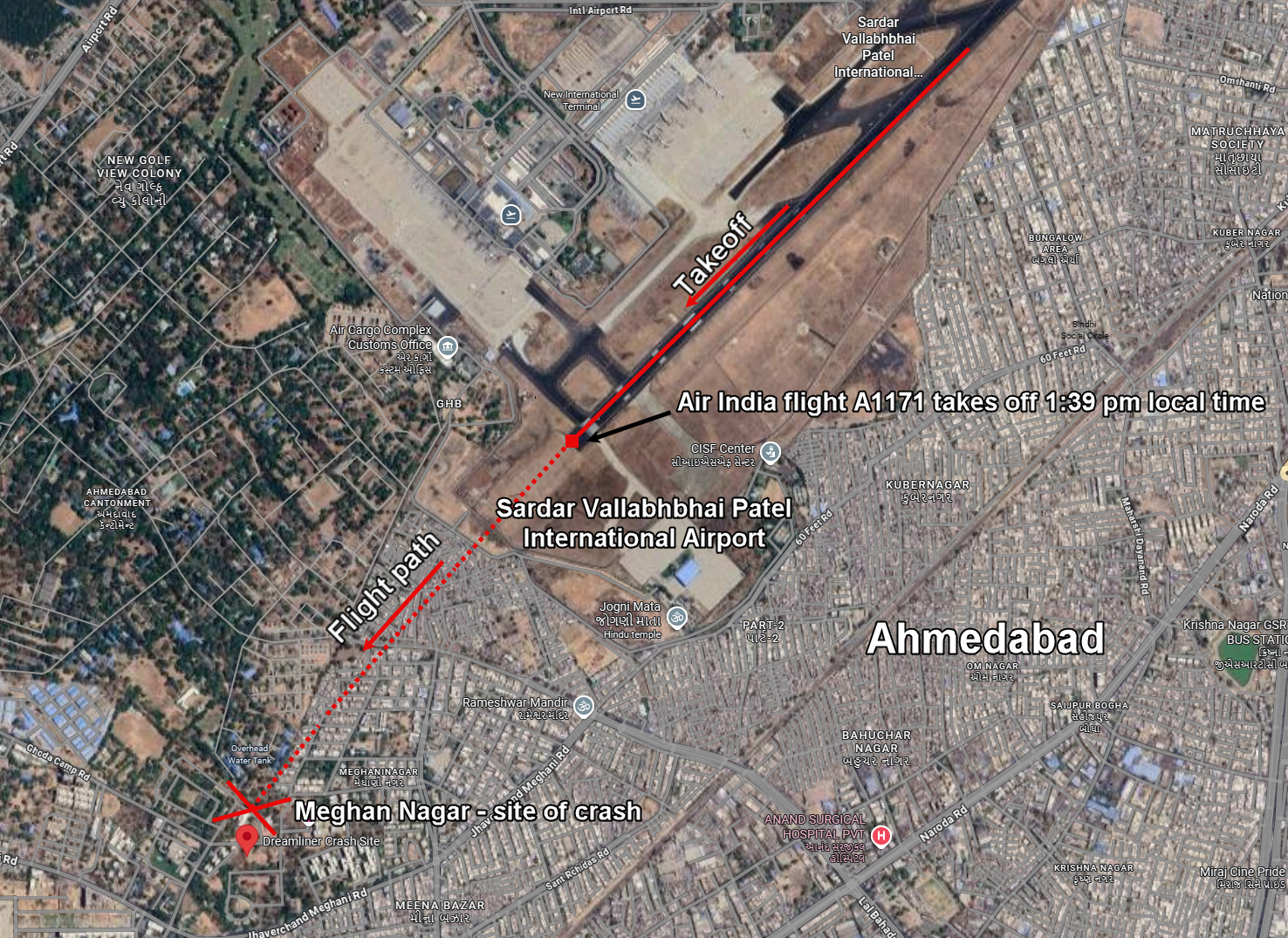

CORRECTION: Jun 16, 2025, corrected height above the ground to 71 feet. Was 625 feet.
On 12 June 2025 at 1:38 pm local time, Air India Flight AI171, a Boeing 787-8 Dreamliner (registration VT-ANB), crashed immediately after takeoff from Ahmedabad, India bound for London, UK. It was airborne for only about 30 seconds after liftoff, reaching an altitude of 71 feet above the ground, when it descended at the rate of ~475 ft/min, according to FlightRadar, and crashed into BJ Medical College Hostel and spread debris along a row of apartment buildings. The video shows a huge fireball and black smoke.
A non-stop flight from India to the UK would take off with a long-haul fuel load. The Dreamliner would have had 33,000 gallons (125,000 liters) of aviation fuel, over 3 times the fuel in each of the aircraft that crashed into the World Trade Center on 9/11.
Of the 242 occupants (230 passengers, 12 crew), 241 perished. Twenty-eight more died, and over 60 were injured in the hospital. Literally walking out of the wreckage was the sole survivor, passenger Vishwashkumar Ramesh, seat 11A, a British national of Indian origin. He is hospitalized, in stable condition, and has been visited by Prime Minister Narendra Modi.
Nationalities onboard include no Americans, 169 Indian, 53 British, 7 Portuguese and 1 Canadian citizen.
 It could have been a lot worse. The Ahmedabad metro area has a population of 8.6 million, is India’s 7th most populous city and as all big India cities, tightly packed. However, the site of the crash appears to be a more sparsely populated with the hostel and apartment buildings on relatively spacious grounds.
It could have been a lot worse. The Ahmedabad metro area has a population of 8.6 million, is India’s 7th most populous city and as all big India cities, tightly packed. However, the site of the crash appears to be a more sparsely populated with the hostel and apartment buildings on relatively spacious grounds.
The pilot issued a Mayday call indicating loss of thrust before the uncontrolled descent. Eyewitness and security-camera footage show the aircraft banking and then plunging into the B. Initial reports indicate a loud bang was heard approximately 30 seconds after departure, consistent with a sudden power or control failure.
Both engines failing at once is an extremely rare event, but it has happened due to running out of fuel (this does not apply here, as the flight was taking off with full tanks), ingestion of objects (hail, water deluge, birds, volcanic ash). But from the videos, all these causes can be ruled out in this case.
Investigation and Potential Causes
India’s Aircraft Accident Investigation Bureau has retrieved both flight data and cockpit voice recorders. Early focus areas include the aircraft’s General Electric GEnx engines, wing-flap configuration and landing-gear status. A source close to the probe indicated that investigators are examining possible engine failure, incorrect flap deployment and maintenance lapses. The Directorate General of Civil Aviation (DGCA) has ordered enhanced inspections of all Air India 787-8/9s equipped with GEnx engines, targeting fuel-system parameters, engine-control systems, hydraulic circuits and takeoff-performance settings.
Prime Minister Narendra Modi visited the crash site the next day. Air India and Boeing CEO David Calhoun (or current CEO) expressed condolences; Boeing has pledged full cooperation the beleaguered company is conducting its own investigation. The U.S. National Transportation Safety Board and the U.K. Air Accidents Investigation Branch are assisting.
Investigators aim to issue a preliminary report within the coming weeks once initial recorder data is analyzed. In the interim, the DGCA’s directive ensures grounded inspections to prevent recurrence. A full accident report, with probable cause and safety recommendations, is anticipated within 12 months.
The Market Reacts
Boeing shares fell over 8% in the aftermath. It is India’s largest aviation disaster in years. Air India was once nationally owned but was privatized in 2022. It is now owned by a Tata Group-led consortium that includes Singapore Airlines.
The Aircraft
The Dreamliner involved—Air India 787-8 VT-ANB—was delivered to Air India on 28 January 2014, making it just over 11 years old at the time of the crash. It was the 12th Dreamliner delivered to Air India. According to a Times of India report, citing flight data company Cirium, the aircraft had logged over 41,000 flying hours and nearly 8,000 takeoff and landing cycles since its first flight on December 14, 2013, about “average for that aircraft build year/period.” In the last 12 months alone, it completed about 700 flight cycles.
Boeing’s Woes Continue
Boeing had been having a tough time even before this crash. The trouble started with two fatal 737 MAX crashes (Lion Air 2018, Ethiopian Airlines 2019) that grounded the MAX fleet worldwide. A software redesign allowed them to fly again, but few if any hardware or avionics changes took place. In May 2025, Boeing agreed to pay over $1.1 billion—including victim compensation and compliance investments—to avoid criminal prosecution for the MAX crashes, a settlement widely criticized by victims’ families and lawmakers as insufficient accountability.
Reports of fuselage panel blowouts, missing bolts on door plugs and other assembly defects prompted regulatory scrutiny and forced groundings/inspections of both 737s and 787s in late 2024 and early 2025.
A 2024 machinists strike halted aircraft production for eight weeks, contributing to a multibillion-dollar third-quarter loss, massive share offerings and a headcount reduction of over 17,000 planned in late 2024.
Once flying the highest, Boeing has been overtaken by Airbus.
Air India Woes Continue
Air India’s reputation, suffering for as long as I can remember, a combination of legacy inefficiencies, operational lapses and poor customer experience, now takes a much deeper plunge.
Being nationally owned started it. Air India suffered from chronic overstaffing, opaque decision-making and weak accountability. Bureaucratic processes slowed maintenance approvals and route planning, leaving the airline with an ageing fleet and little agility to respond to operational issues. Industry data and passenger accounts consistently ranked Air India among the world’s worst performers for on-time departures and cancellations. Delays were routinely attributed to scheduling gaps, late maintenance sign-offs and crew-rostering issues.
Until Tata Group’s 2022 takeover, much of Air India’s fleet consisted of older Boeing 777s, 747s and early Dreamliners. These aircraft demanded more frequent checks and were prone to technical snags.
Skytrax rates Air India as a 3-star carrier, well below the “world-class.” Passenger reviews on platforms like AirlineQuality.com describe “nightmares” of dirty cabins, antiquated seats, indifferent cabin crews and unreliable catering. Frequent flyers on social media routinely complain about an “atrocious” website, long baggage-claim waits and inconsistent ground-staff support.
Air India posted a net loss of roughly $520 million in FY 2023–24, driven by high operating costs, fuel-inefficient aircraft and stiff competition from low-cost carriers like IndiGo.
Since its privatization in early 2022, Tata Sons (with Singapore Airlines as a minority partner) has injected capital and placed large aircraft orders—but operational culture and legacy systems proved slow to change. Despite high-profile management changes and modernization plans, many service and maintenance gaps persisted into 2025, delaying the transformation into a truly “world-class” airline, according to the Wall Street.
